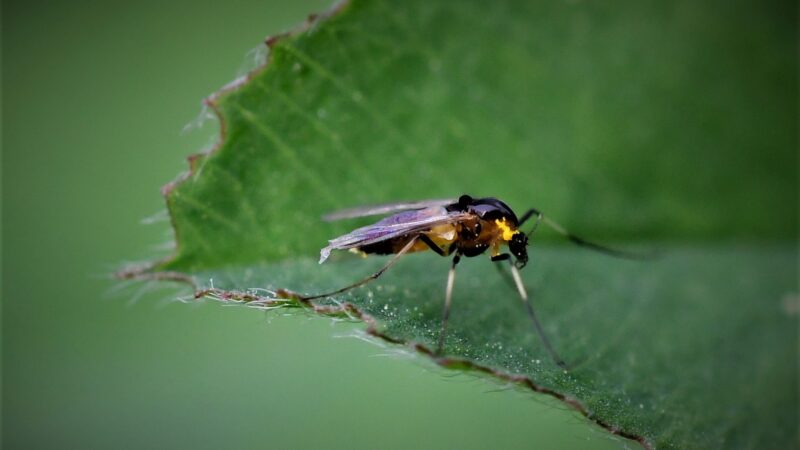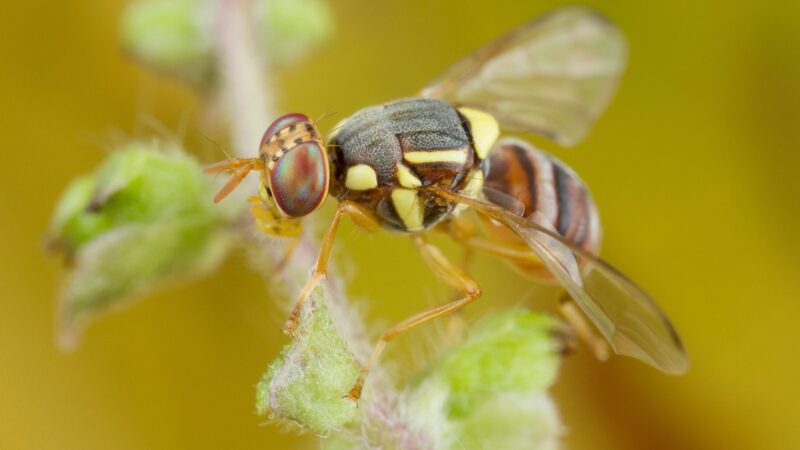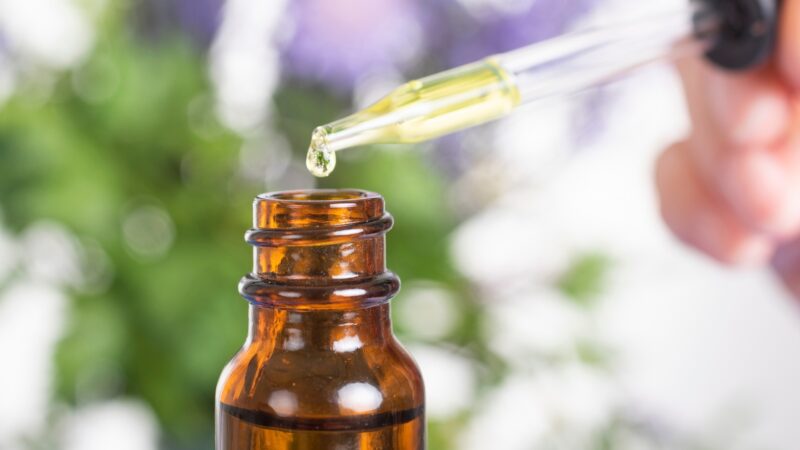Gnats and fruit flies are insects that can lead to severe infestation if ignored. Aside from being inexpensive, essential oils are generally effective in treating these infestations and safe for humans and pets.
To use essential oil in getting rid of gnats and fruit flies, mix it with water in a spray bottle. Then, spray the solution in areas where these pests are present. Instead of water, you may use alcohol or combine different essential oils to make an insect spray.
Related: Eliminate Fruit Flies Forever | Proven Techniques and Tips!
Gnat Identification

Scientific Name
Gnats are any species of small flies in the suborder Nematocera rather than a particular insect. Because of this, they don’t have a specific scientific name. Nonetheless, these tiny flying insects belong to the insect families Anisopodidae, Cecidomyiidae, Mycetophilidae, and Sciaridae.
Appearance
So far, there is no scientific consensus on what makes a gnat a gnat. Regardless of the family a particular gnat species belongs to, all of them are generally referred to as fungus gnats.
Also called dark-winged fungus gnats, fungus gnats look like mosquitoes. Both of them have segmented antennae and six slender, long legs.
Adult fungus gnats have a pair of gray-to-white wings and a distinct Y-shaped pattern on their forewing veins, which makes them different from other small flies. They have three body parts – the head, thorax, and abdomen. Fungus gnat larvae (maggots) are thread-like and have a shiny black head capsule but without legs.
Size
Adult fungus gnats are about 1/10 to 1/8 inch (2.54 to 3.2 mm) long and are almost as big as adult mosquitoes. On the other hand, their legless larvae are 1/4-3/8 inches (6.35-9.53 mm) long.
Color
Adult fungus gnats are usually black or dark brown, while larvae have white or transparent bodies.
Shape
Adult fungus gnats have the same body shape as adult mosquitoes, while larvae are thin and long.
Habitat
Fungus gnats reproduce and develop in moist, shaded environments such as greenhouses, nurseries, and even houses that have indoor plants. Outdoors, they can also be found in areas where there is high humidity and organic matter. Adults don’t bite and are not destructive, but larvae cause root damage to plants.
What Causes Gnats?
Aside from plant roots, fungus gnat larvae feed on plants’ lower stems, dead leaves, rotting organic matter, and fungi or molds that build up due to moisture. Therefore, gnats are caused by poor drainage or overwatering of potted plants. Adult fungus gnats are also attracted to lights and are nuisances when indoors.
Adult fungus gnats inside homes are also due to excess moisture or water leak in bathrooms and kitchens. These uninvited guests are weak flyers and rarely fly from one place to another. However, larvae may enter your house once someone accidentally brings infested potted plants inside.
Related: How to Get Rid of Gnats in House? | 9 Effective Ways
Fruit Fly Identification

Scientific Name
The scientific name of the common fruit fly is Drosophila melanogaster. In Greek, Drosophila was derived from the word Drosos, which means “dew loving.”
Also sometimes referred to as vinegar fly, pomace fly, or less fruit fly, this fly species is one of the most commonly studied organisms in terms of human diseases.
Appearance
At first glance, fruit flies look like common house flies and fungus gnats since they all have the same body parts with six legs. However, fruit flies have brick-red compound eyes and miniature wings, and their legs are shorter. Upon looking closer, you will notice that their bodies are full of spiky hairs, especially in males.
On the other hand, fruit fly larvae have black mouthparts but no eyes and no legs. They also have a pair of spiracles (air intakes) at their anterior (front), and posterior (back) ends.
As these legless larvae undergo molting periods, the number of teeth on their dark-colored jaw hooks increases until they pupate.
Size
Adult fruit flies are around 1/8 inches (3.2 mm) long, while larvae are about 1/4 inch (6.35 mm) long.
Color
Adult fruit flies are usually tan in the front portion of their bodies and black in their rear portion. Adult males have a distinct black patch on their abdomen, while adult females have none. Like gnat larvae, fruit fly larvae are usually transparent. This is why you can see their internal organs.
Shape
Adult fruit flies have a small, slender body shape and straight, flat wings, which is typical of most flies. On the other hand, larvae have a slightly curved body shape.
Habitat
Fruit flies live in various environments, but most are found in overripe or rotting fruits and vegetables. No wonder you see them in kitchens, empty cans and bottles, and trash cans with food scraps. They also live in dark, damp areas such as drains, fruit and vegetable gardens, and stores.
What Causes Fruit Flies?
Overripe or rotting fruits, vegetables, and other fermenting organic matter will cause fruit flies. These tiny flies are attracted to fermented yeast and lay eggs on them.
They also breed in moist areas such as dishcloths, cleaning rags, sponges, and other wet items in kitchens.
Contrary to what some people might think, fruit flies are not only attracted to fruits and other sources of sugar. They are also attracted to moisture and any kind of fermenting material.
Fruit flies feed on surfaces with sugary substances such as overripe or rotting fruits and fermented liquids such as beer and vinegar.
Related: How to Get Rid of Fruit Flies for Good? | Tips and Guide
Essential Oils That Can Get Rid of Gnats and Fruit Flies

Repelling gnats and fruit flies can be challenging since they reproduce very quickly. Some pesticides kill these pests insects, but most of them contain chemicals.
Fortunately, there are some natural methods, such as using essential oils. Below are some common essential oils that can get rid of gnats and fruit flies:
1. Peppermint Essential Oil
With menthol being its primary component, peppermint essential oil is considered the holy grail of plant-based oil insect repellents and is also the most popular one. Various studies suggested that peppermint oil effectively repels common house pests, including mice, mosquitoes, flies, and spiders.
- Packaging May Vary - New look, same great product.
- Certified Organic Peppermint Oil - Cliganic organic essential...
- 100% Pure, Single Ingredient Oil - Cliganic organic essential...
- Multipurpose Essential Oil – Cliganic essential oils are...
- 3rd Party Tested for Purity - Each batch is being tested for...
2. Lavender Essential Oil
The lavender essential oil contains non-toxic compounds, including eucalyptol and linalool, used in many pest control products. Despite its subtly sweet and floral aroma, linalool has a similar effect on mosquitoes as DEET. According to a study, inhaling lavender essential oil has decreased locomotion in mice.
3. Neem Essential Oil
Neem essential oil contains Azadirachtin, a white microcrystalline solid with a strong sulfurous odor despite containing no sulfur. According to the EPA, neem essential oil interferes with the insect’s daily activities and life cycle. This includes egg-laying, feeding, mating, molting, and overall growth.
4. Tea Tree Essential Oil
Tea tree essential oil is another plant-based oil that has been studied as an effective insect repellent. Among the pesky insects that can be repelled by tea tree oil are ants, flies, and mosquitoes. In some cases, this essential oil also kills insects and can work better than standard insecticides and repellents.
5. Eucalyptus Essential Oil
Eucalyptus essential oil is considered a natural pesticide rather than an insect repellent. The pesticidal properties of eucalyptus oils have been due to several components such as acetate, citronellal, and linalool. However, OLE (lemon eucalyptus oil) is not the same as lemon eucalyptus essential oil.
6. Cedarwood Essential Oil
There are different types of cedarwood essential oil, which include the Atlas, Himalayan, and Virginian cedarwood. The EPA has registered cedarwood oil since 1960 as a pesticide that repels moths from clothing. Although it does not repel mosquitoes well, this essential oil can deter other insects, such as flies.
7. Citronella Essential Oil
Citronella essential oil contains citronellol, citronellal, and geraniol and is another naturally occurring insect repellent. Due to its grassy and floral scent, it is known for repelling adult and larvae of house flies and mosquitoes. Citronella oil is also common in more than a dozen registered pesticide products.
8. Lemongrass Essential Oil
Lemongrass essential oil is also one of the most popular all-natural insect repellents. It contains aromatic and antimicrobial compounds and insecticidal compounds such as geraniol. Interestingly, lemongrass is the closest cousin of citronella, but the former is a bit better at repelling insects such as gnats and flies.
9. Geranium Essential Oil
Geranium essential oil is extracted from the leaves of the sweet-scented geranium plant (Pelargonium graveolens). Like lemongrass essential oil, geranium oil also contains geraniol and works well as an insect repellent. Based on a study, geranium oil seems to be as effective as citronella oil in repelling fruit flies.
10. Clove Essential Oil
Clove essential oil is derived from the flower buds, leaves, and stems of the clove plant (Syzygium aromaticum). Its main active component is eugenol, widely used as a food flavoring. Clove oil is also known for its insecticidal bioactivities against different insect species, such as mosquitoes and fruit flies.
Note: While all essential oils mentioned above are effective in getting rid of gnats and fruit flies, their efficacy still depends on how you use them and the severity of the problem. And since these oils contain volatile compounds, they evaporate quickly, and re-application may be necessary in most cases.
How to Use Essential Oils to Eliminate Gnats and Fruit Flies?
Eliminating gnats and fruit flies using essential oils is quite easy. Simply mix 10-20 drops of essential oil with 2 oz of distilled water in a spray bottle and shake well. Then, spray the solution directly on these insects. Alternatively, dip some cotton balls in the solution and leave them in the areas where these pests are.
To be more effective, add 2 oz of white vinegar to the solution. You can also mix as many kinds of essential oils as you want.
But again, results may vary, and using essential oils as insect repellents is not always effective. But more importantly, some may affect non-target species, such as cats and dogs.
What Prevents Gnats and Fruit Flies From Your Home?
Adult gnats and fruit flies can fly, and their larvae can squeeze their bodies in small gaps. No wonder these pesky insects can enter your house without your knowledge. Although you can see them during the day, repelling them can still be challenging. Therefore, here are some ways to prevent them from coming back:
For Gnats:
- Seal all possible entry points.
- Check plant pots for excessively moist conditions before bringing them inside your house.
- Avoid overwatering your plants.
- Allow the soil surface to dry before watering again.
- Improve your drainage.
- Always clean up standing water.
- Repair plumbing leaks as soon as possible.
- Clear around your house of organic debris.
- Apply live beneficial nematodes on plants. These microscopic roundworms kill gnat larvae and eat them.
- Can be use around animal, pets and plants
- Each package contains: 5 million Sf ( Steinernema feltiae)
- Release Rate: up to 300 sq.ft. of garden, lawn or soil
For Fruit Flies:
- Inspect fruits and food packages thoroughly before buying them.
- Buy fruits and vegetables that you can consume only for a week.
- Wash fruits and other food items right after you get home and store them immediately.
- If you do not yet eat your fruits, store them in sealed containers or inside the refrigerator.
- Check for rotting fruits and vegetables and throw them right away.
- Make sure your kitchen and food storage area is clean and dry.
- Replace overused dishwashing sponges and other cleaning tools.
- Always cover your garbage cans. Empty and clean them before going to sleep.
- Place yellow sticky traps such as Garsum Fruit Fly Sticky Trap in areas where insects can find food.
- Based on physical principles: The Sticky Pest Trap is a bright...
- Long-lasting And Durable: UV-resistant and waterproof. Resistant...
- Thoughtful Design: Reserved glue-free section so that it won't...
- Eco-friendly And Natural Control: Harmless and odorless,...
- Multiple Scenarios Use: Specially designed to catch flying plant...
List of Sources
Bethke, J. A., Dreistadt, S. H. (2013). Fungus Gnat. Agriculture and Natural Resources, University of California.
Potter, M. F. (1994). Fruit Flies. University of Kentucky Entomology.
Azadirachtin (121701) Clarified Hydrophobic Extract of Neem Oil (025007) Fact Sheet. U.S. Environmental Protection Agency.
Linck, V. M., et al. (2009). Inhaled linalool-induced sedation in mice. Phytomedicine : international journal of phytotherapy and phytopharmacology.
- How to Get Rid of Copperheads | Practical Guide - August 27, 2023
- How to Get Rid of Corn Snakes | What Makes Them Aggressive? - August 27, 2023
- How to Get Rid of Alligators | Safety Measures and Removal Methods - July 16, 2023




